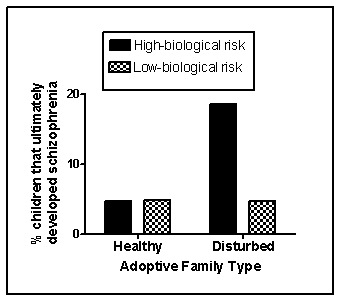Scenario II
The following scenario presents fabricated data consistent with the results of the following study:
Tienari, P., Wynne, L. C., Sorri, A., Lahti, I., Läksy, K., Moring, J., & ... Wahlberg, K. (2004) . Genotype-environment interaction in schizophrenia-spectrum disorder: Long-term follow-up study of Finnish adoptees. The British Journal of Psychiatry, 184(3) , 216-222. doi:10.1192/bjp.184.3.216
Schizophrenia affects approximately 1 percent of the general population and is characterized by the profound disruption of basic psychological processes; a distorted perception of reality;, altered or blunted emotional affect; and disturbances in thought, motivation, and behavior. The symptoms of schizophrenia are varied and are typically classified as either positive or negative. Positive symptoms of schizophrenia refer to thoughts and behaviors typically not observed in those without the disease, and can include things like delusions (patently false beliefs) , hallucinations (false perceptual experiences) , and disorganized speech. Negative symptoms of schizophrenia are deficits or disruptions in normal behaviors, such as social withdrawal. Cognitive deficits in executive functioning, attention span, and working memory also may be observed.
The symptoms of schizophrenia usually begin in late adolescence and the disease has a strong genetic component. Over the years, a number of biological factors have been linked to schizophrenia, although none alone adequately accounts for the disorder. One such example is the dopamine hypothesis, which states that schizophrenia is related to an excess in dopamine activity. Another theory points to enlarged brain ventricles and progressive cortex tissue loss as predictive of schizophrenia, although only a minority of persons with schizophrenia have enlarged ventricles, this structural anomaly can appear in those without the disease, and dopamine antagonists also may produce this effect.
Although research into the environmental determinants of schizophrenia has focused largely on the prenatal environment, psychological and social factors also contribute. Tienari et al. (2004) compared the risk of developing schizophrenia in children adopted into healthy versus disturbed families, the latter characterized by extreme conflict, volatile relationships, and communication deficits. Some of these children under investigation were identified as at-risk genetically for schizophrenia because their biological mothers were schizophrenic. The remainder was classified at low risk. The investigators utilized a longitudinal design and obtained the diagnostic status of the children with respect to schizophrenia when they reached young adulthood. Fabricated results consistent with this study are shown in Figure 15.2
Figure 15.2 
-(Scenario II) The results shown in Figure 15.2 demonstrate that:
Definitions:
Open Market
A scenario where trading of goods, services, securities, or assets occurs in a free and unrestricted environment, often characterized by a competitive marketplace.
Sale
Sale involves the exchange of goods or services for money, constituting a transaction between two or more parties.
Non-controlling Interest
A portion of the equity in a subsidiary not owned directly or indirectly by the parent company.
Voting Shares
Voting shares represent ownership in a company with the rights to vote on corporate policy and decisions.
Q2: Summarize the key distinguishing features of the
Q3: Interpersonal psychotherapy (IPT) is less intensive than
Q21: IPT is different from traditional psychoanalysis in
Q27: Among people who have just had heart
Q34: Dieters are better off focusing on increasing
Q68: The general adaptation syndrome in reaction to
Q69: Scott is having relationship problems with his
Q99: The heritability estimate for major depression _
Q104: In group therapy, the therapist typically takes
Q112: When 1000 members of the American Psychological